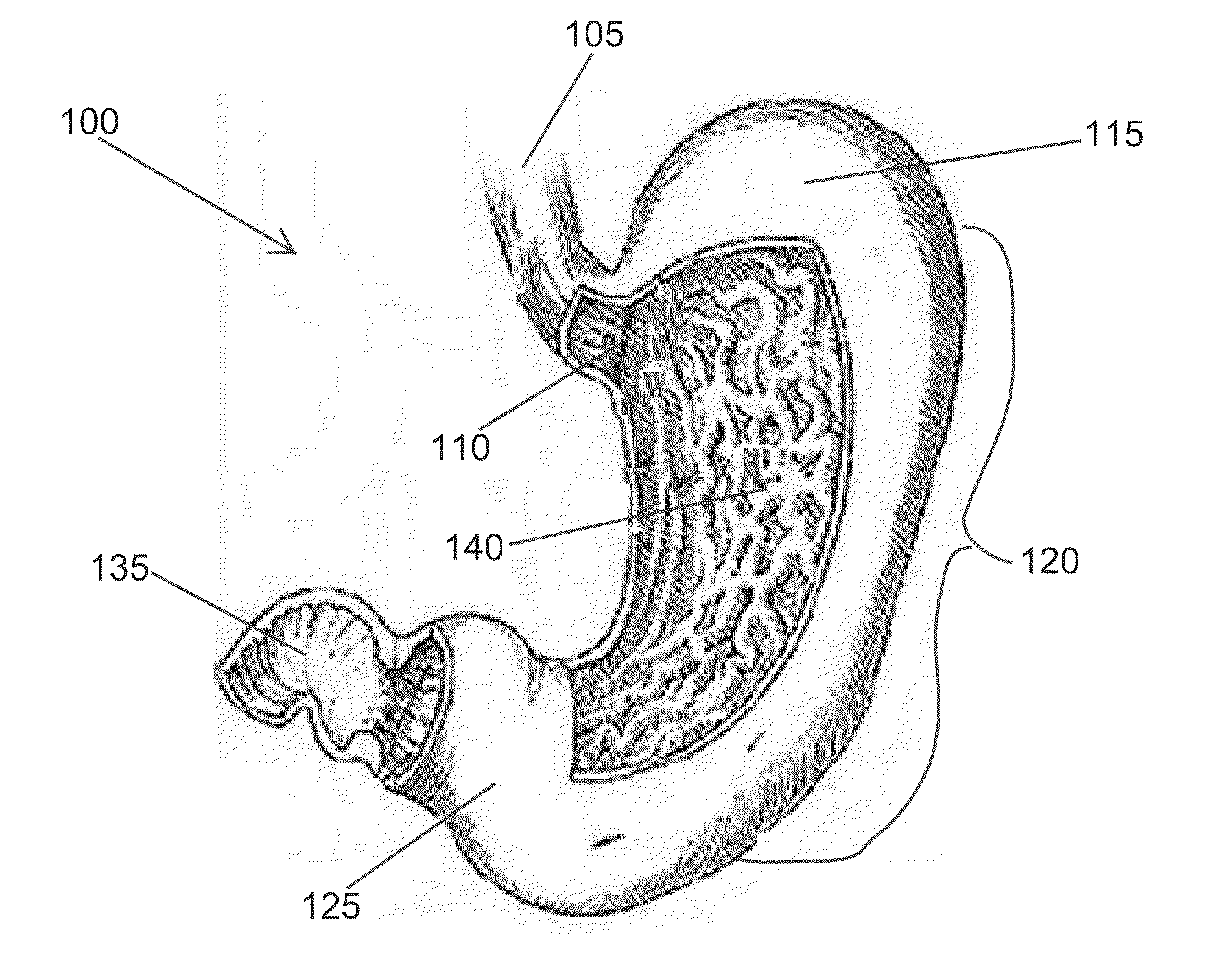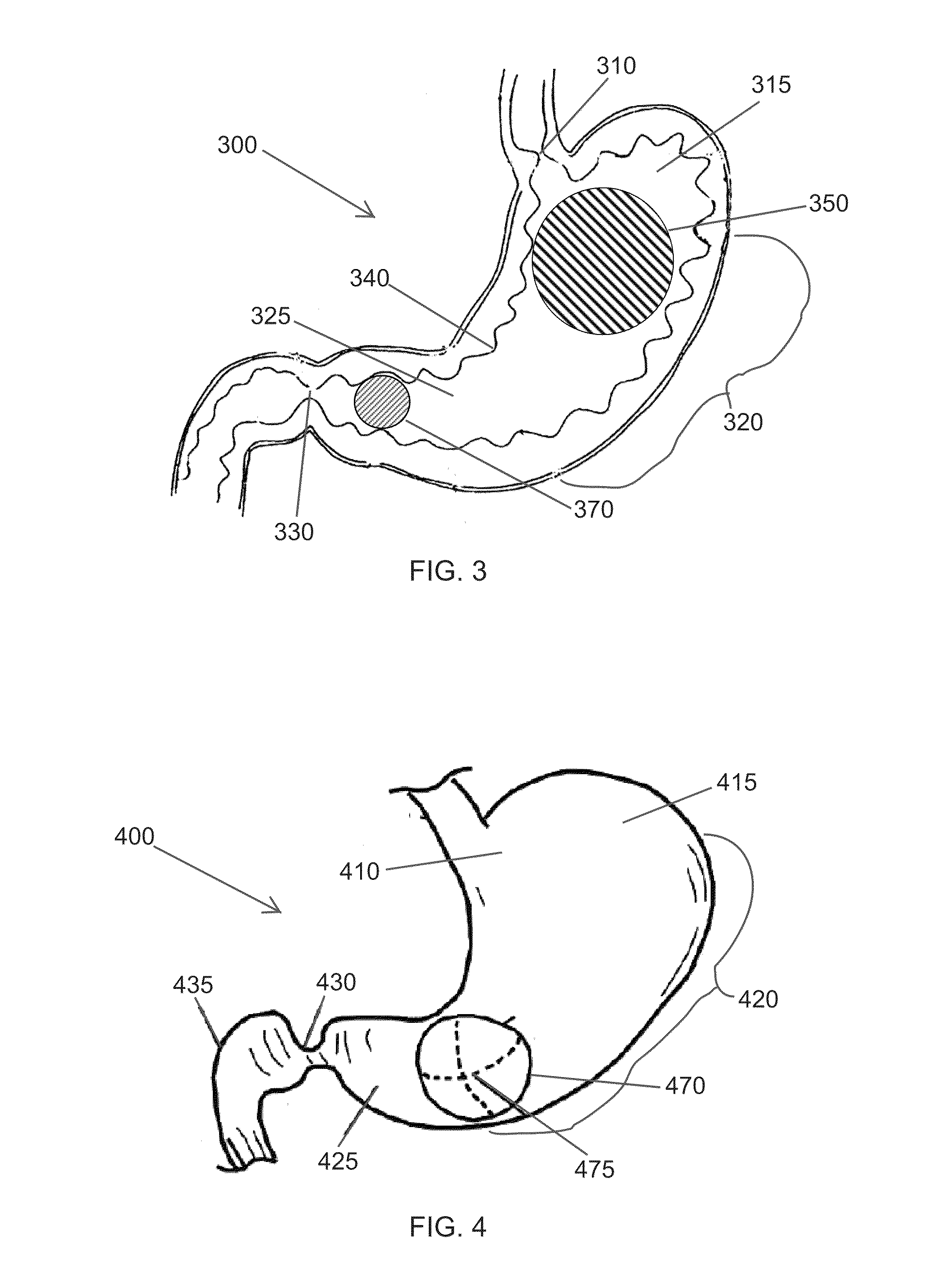High specific gravity intragastric device
a high specific gravity, intragastric device technology, applied in the direction of dilators, obesity treatment, surgery, etc., can solve the problems of 72 million adults morbidly obese in the us, increase the length of hospital stays, and impact on overall healthcare costs, and achieve the effect of increasing the specific gravity
- Summary
- Abstract
- Description
- Claims
- Application Information
AI Technical Summary
Benefits of technology
Problems solved by technology
Method used
Image
Examples
example 1
Relative Effect of Increasing Specific Gravity
[0081]This example compares a 1.0 g / ml specific gravity intragastric balloon sitting in a 1.0 g / ml water bath to the behavior of similar sized balloons having a specific gravity greater than that of the surrounding fluid bath.
Methods
[0082]Test samples having a Specific Gravity of 1.0 g / ml, 1.21 g / ml, 1.46 g / ml, 1.88 g / ml, and 2.07 g / ml were prepared from 75 cc latex balloons filled with distilled water, and adding steel pellets for ballast to increase the specific gravity to desired range.
[0083]The weight and displacement of each sample was measured after the balloons had been filled, air expelled and tied closed with a single knot. The targeted specific gravities were in range of 1.0 g / ml, 1.2 g / ml, 1.5 g / ml, 1.9 g / ml, and 2.1 g / ml. All quantitative measurements were taken at room temperature.
[0084]Step 1: Each sample was placed into the bottom of an empty, two liter open-top glass flask. One liter of tap water was added over a period o...
example 2
Selection of the Specific Gravity of an Intragastric Device
[0097]This example shows the behavior of a variety of the intragastric devices in a variety of simulated meals. If meal contents are of a higher density than the intragastric device, the device will not likely be gravitationally directed to the distal stomach during feeding times. As such, the device will not likely act on the antral region, which makes it unlikely it will influence eating behavior by exerting pressure on the antrum walls.
[0098]The intragastric device needs to be relatively heavier than typical meal contents, but it should not be excessively heavy, as that might cause an injury, such as plugging up the outlet path from the stomach to the intestines, or possibly producing pressure on the gastric walls that leads to ulceration or pain.
[0099]The following results demonstrate that the specific gravity of many typical foods can be a bit higher than one might expect. The results provide the range of specific gravi...
example 3
Leak Resistance of Optional Fill Media
[0113]This example shows the leak resistance of devices that include the use of novel filling media and techniques. It has been demonstrated that an increased leak resistance can be provided by using a hydrogel fill formulation to expand the intragastric devices. Interestingly, this innovation can apply to current state of the art intragastric balloons, as well as the intragastric devices taught herein.
[0114]Intragastric balloon treatments can take an extended period of time. Reviews of intragastric balloon use in the medical literature often cite the deflation of devices before the intended treatment time is achieved. Typically, existing balloon-based devices cannot be left in place longer than about 6 months due to the likelihood of deflation, which can lead to the passage of the deflated device down into the intestinal tract and cause obstruction or other injury. As such, one of skill will appreciate having a device that resists deflation for...
PUM
 Login to View More
Login to View More Abstract
Description
Claims
Application Information
 Login to View More
Login to View More - R&D
- Intellectual Property
- Life Sciences
- Materials
- Tech Scout
- Unparalleled Data Quality
- Higher Quality Content
- 60% Fewer Hallucinations
Browse by: Latest US Patents, China's latest patents, Technical Efficacy Thesaurus, Application Domain, Technology Topic, Popular Technical Reports.
© 2025 PatSnap. All rights reserved.Legal|Privacy policy|Modern Slavery Act Transparency Statement|Sitemap|About US| Contact US: help@patsnap.com



